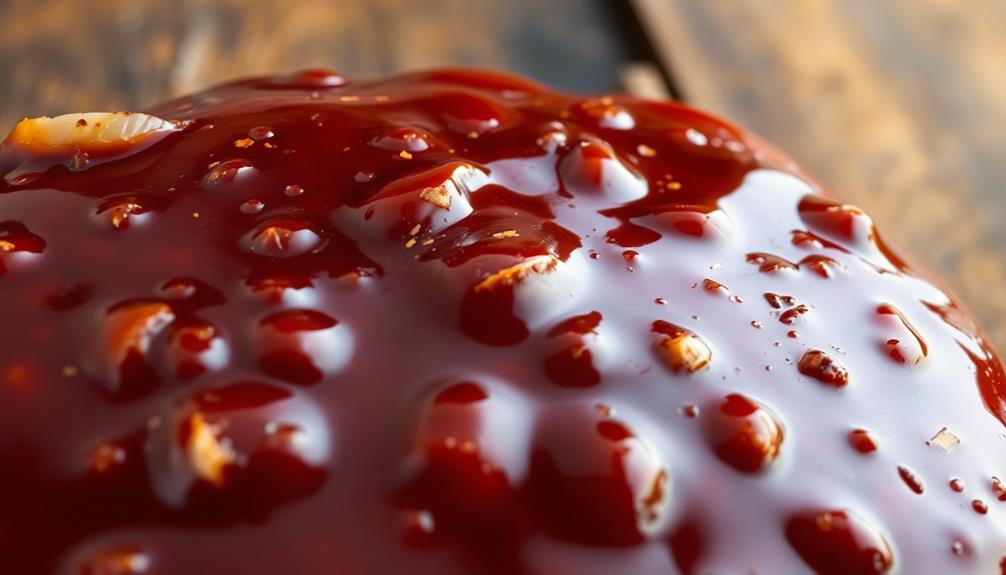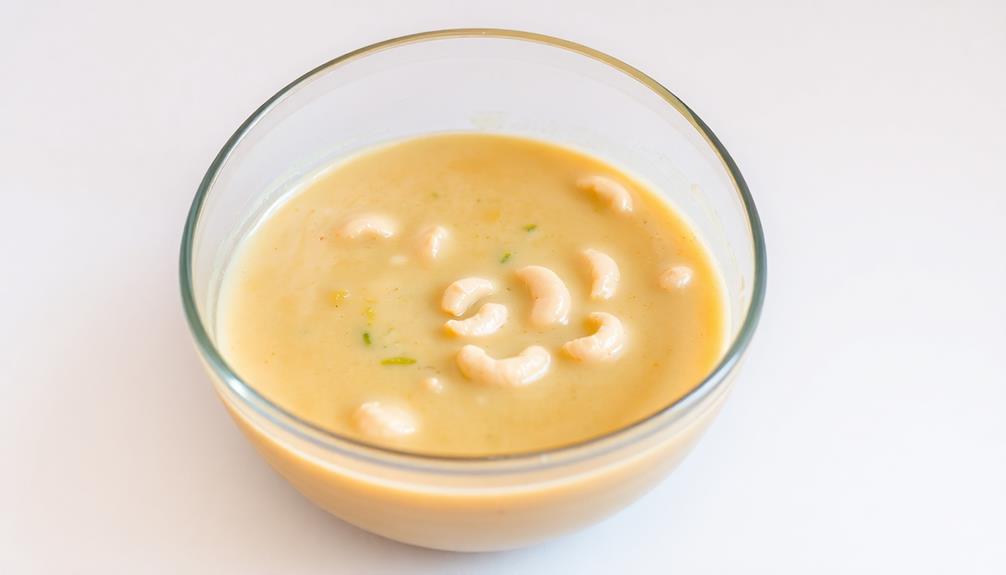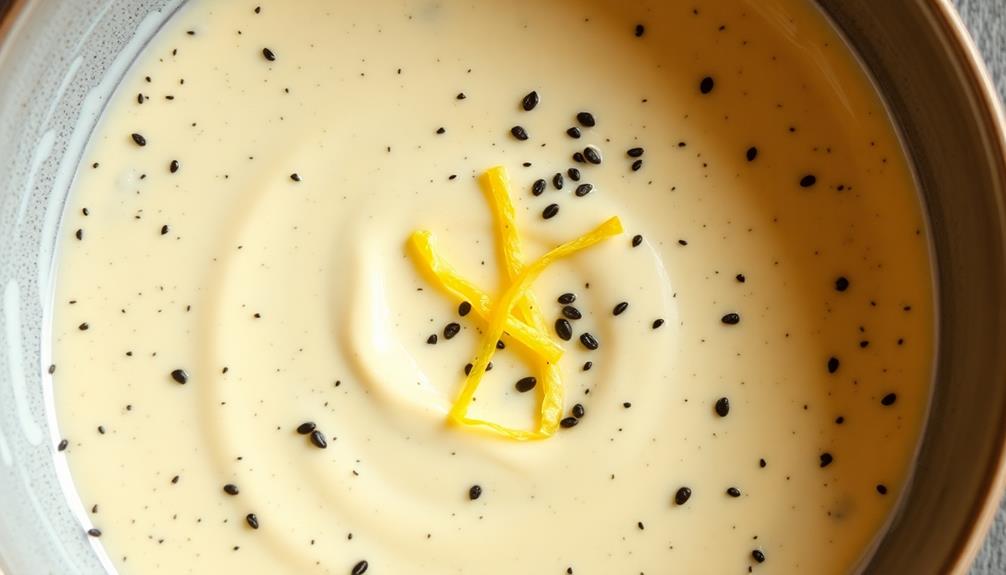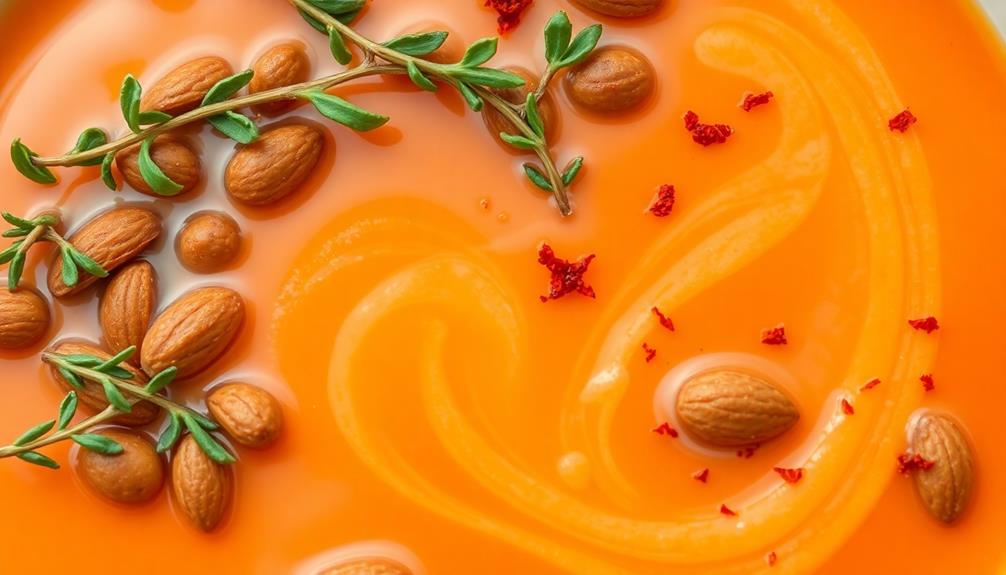Mango chutney is a delightful condiment that's been delighting taste buds for centuries! It originated in India and has evolved into diverse flavors across the region. This sweet and tangy preserve is a versatile companion, brightening up curries, meats, and sandwiches. You can customize the spices, sweetness, and acidity to suit your preferences. The secret is balancing the flavors – the mangoes, vinegar, and brown sugar create an irresistible harmony. Once you've mastered the simple steps to make your own, you'll be amazed at all the tasty ways you can enjoy this vibrant chutney.
Key Takeaways
- Mango chutney is a sweet and tangy Indian condiment with a rich history dating back to the 6th century AD.
- It is a versatile accompaniment that complements various dishes, including curries, grilled meats, and sandwiches.
- The recipe typically includes mangoes, onion, garlic, ginger, vinegar, and brown sugar, allowing for customization of flavors.
- Proper preparation and storage in sterilized jars ensures the chutney's freshness and shelf life of up to 3 months in the refrigerator.
- Mango chutney's diverse applications, from spreading on toast to enhancing salad dressings and sandwiches, showcase its culinary versatility.
History
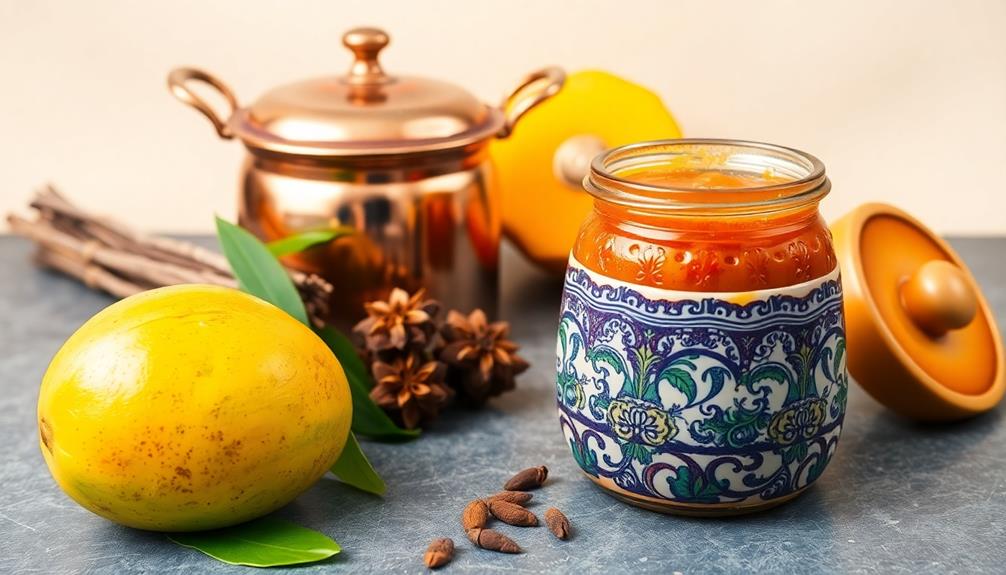
Mango chutney traces its origins back to the Indian subcontinent, where it has been a staple condiment for centuries. The earliest records of this delightful treat date back to the 6th century AD, when it was enjoyed by the ruling classes and commoners alike.
Over time, mango chutney evolved, with each region developing its own unique flavors and textures. The creation of mango chutney can be likened to the developmental benefits of culinary traditions, showcasing the creativity and resourcefulness of those who prepared it.
From the sweet and tangy varieties of the north to the spicier versions found in the south, the diversity of mango chutney reflects the rich culinary heritage of India.
As traders and explorers ventured out, the recipe spread to other parts of the world, becoming a beloved accompaniment to curries, grilled meats, and even sandwiches.
Today, mango chutney continues to captivate taste buds worldwide, a testament to its enduring popularity and the vibrant culinary traditions that gave birth to this extraordinary condiment.
Recipe

Mango Chutney is a delightful condiment that can liven up a variety of dishes. This sweet and tangy preserve is a staple in Indian cuisine, but its versatility makes it a beloved addition to many culinary traditions. The recipe below will guide you through the process of creating a homemade mango chutney that's bursting with flavor.
Butter can enhance the experience of enjoying chutney, especially when paired with warm naan or used to baste grilled meats for added richness, making it a great complement to your meals. The creamy texture of butter enhances flavor and moisture in baked goods, which can also be a delightful pairing with mango chutney.
Chutney is a broad term that encompasses a range of spiced, pickled, or cooked fruit or vegetable preparations. In the case of mango chutney, the vibrant, juicy flesh of the mango is transformed into a complex and aromatic preserve. The combination of sweet, sour, and savory elements creates a harmonious balance that can elevate any meal.
Ingredients:
- 4 large mangoes, peeled, pitted, and diced
- 1 onion, finely chopped
- 3 cloves of garlic, minced
- 1 inch piece of ginger, peeled and grated
- 1 teaspoon cumin seeds
- 1 teaspoon mustard seeds
- 1 teaspoon coriander seeds
- 1 teaspoon chili powder
- 1 cup apple cider vinegar
- 1 cup brown sugar
- 1 teaspoon salt
Instructions:
In a large saucepan, combine the diced mangoes, chopped onion, minced garlic, and grated ginger. Add the cumin seeds, mustard seeds, coriander seeds, and chili powder.
Pour in the apple cider vinegar and brown sugar, then stir in the salt. Bring the mixture to a boil over medium-high heat, then reduce the heat and let it simmer, stirring occasionally, for about 30-40 minutes, or until the chutney has thickened to your desired consistency.
It's important to note that mango chutney can be customized to suit your personal taste preferences. You can adjust the amount of spices, sweetness, or acidity to find the perfect balance for your palate.
Additionally, the chutney can be stored in sterilized jars in the refrigerator for up to 2 months, allowing you to enjoy its flavors long after preparation.
Cooking Steps
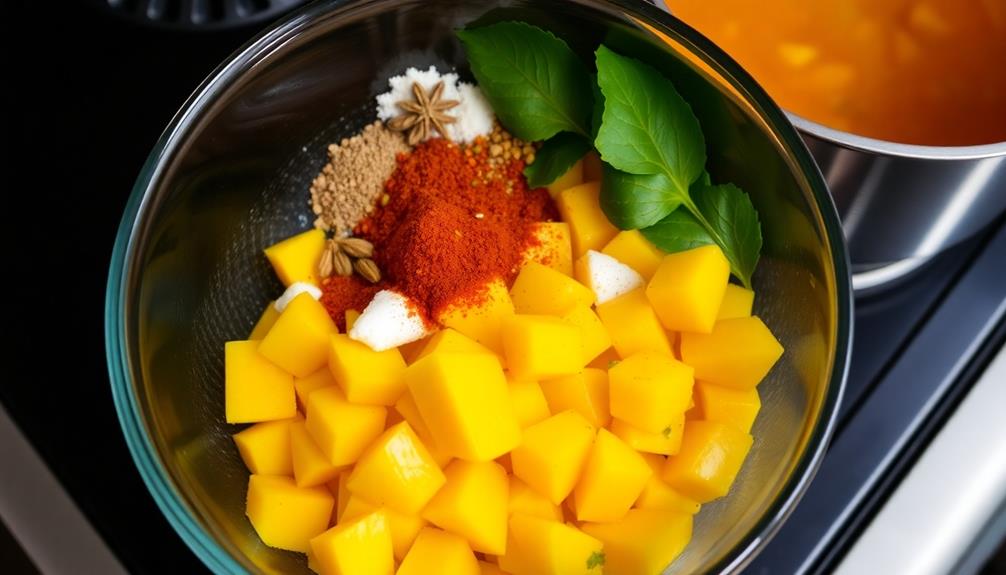
Start by chopping those mangoes into nice small pieces.
For a unique twist, consider adding some fresh herbs like basil or mint to enhance the flavor profile, much like in herb-infused cocktails.
Then, you'll add some vinegar and tasty spices to the mix.
Finally, let it all simmer until it's nice and thick, stirring occasionally.
Once it's ready, you can transfer the delicious chutney to some sterilized jars for storage.
Step 1. Chop Mangoes Into Small Pieces

Once the mangoes have been washed and peeled, it's time to chop them into small, bite-sized pieces. Get out a sharp knife and a sturdy cutting board – you'll need them for this step.
Carefully slice each mango in half, avoiding the large pit in the center. Then, use the knife to cut the mango halves into thin strips. Finally, turn the strips and chop them crosswise to create those perfect little mango cubes. Be sure to work slowly and safely, taking care not to cut yourself.
Now you've got a pile of fresh, chopped mangoes ready to go! The sweet, juicy pieces will add a delightful flavor to your homemade chutney.
Next, you'll need to gather the rest of the ingredients and start cooking. Get ready for your kitchen to be filled with the aromatic scent of spices and the bright, tropical notes of mango. Mmm, it's going to be delicious!
Step 2. Add Vinegar and Spices

With the mangoes chopped, it's time to add the vinegar and spices. In a large bowl, pour in 1/2 cup of apple cider vinegar. The vinegar will help balance the sweetness of the mangoes and give the chutney a nice tangy flavor.
Next, sprinkle in 1 teaspoon of ground cumin, 1 teaspoon of ground coriander, and 1/2 teaspoon of cayenne pepper. These spices will add warmth and a little kick to the chutney.
Stir everything together until the mangoes are evenly coated. The vinegar and spices should create a vibrant, fragrant mixture.
Let the chutney sit for about 30 minutes, allowing the flavors to meld. During this time, the mangoes will soften and the spices will become more pronounced.
When you're ready, give it another good stir. Your mango chutney is now ready to be enjoyed! Serve it as a condiment for curries, rice dishes, or even on top of grilled meats. Mmm, the sweet and tangy flavors are simply irresistible.
Step 3. Simmer Until Thickened
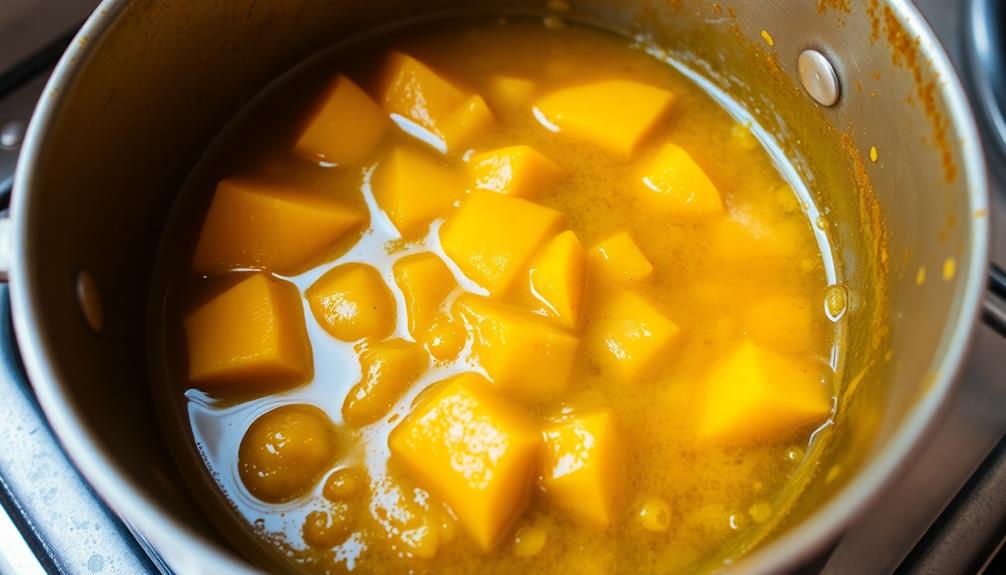
Next, transfer the flavored mango mixture to a saucepan.
Bring the mixture to a gentle simmer over medium heat, stirring occasionally. As the chutney simmers, the juices will start to thicken and the flavors will meld together beautifully.
Don't be tempted to crank up the heat – slow and steady is the way to go here.
After about 15-20 minutes of simmering, the chutney should have a nice, spreadable consistency.
You'll know it's ready when it coats the back of a spoon nicely.
Give it a taste and adjust the seasoning if needed, adding a pinch more salt or a splash of vinegar to balance the sweetness.
Once it's reached the perfect texture, remove the saucepan from the heat and let the chutney cool slightly.
Soon, you'll have a delightful, homemade mango chutney that's perfect for serving alongside roasted meats, curries, or your favorite cheeses.
Get ready to impress your friends and family with this tasty condiment!
Step 4. Stir Occasionally
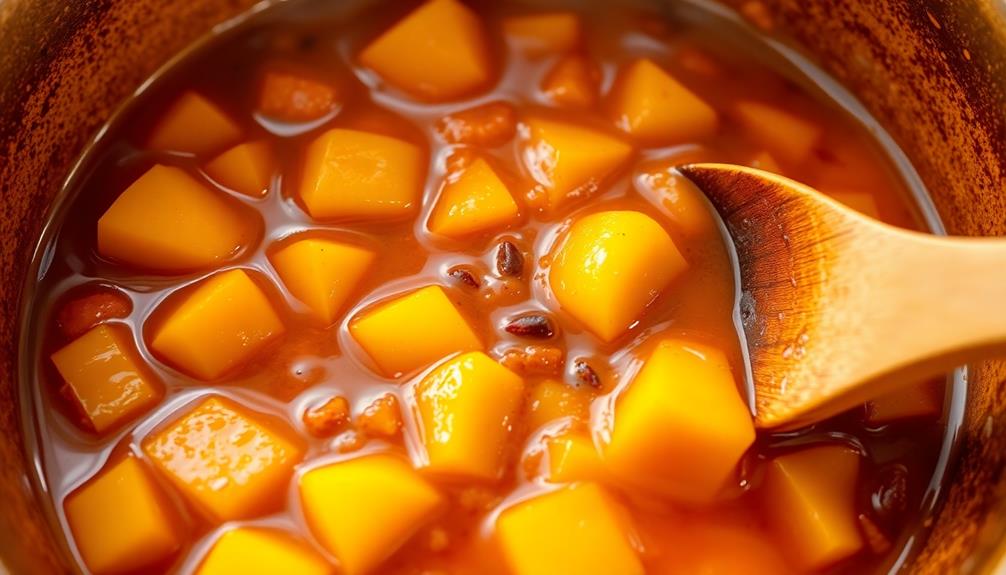
As the chutney simmers, be sure to stir it occasionally. This helps the flavors mingle and prevents anything from sticking to the bottom of the pot. Every few minutes, grab a wooden spoon and give the mixture a gentle swirl.
Don't be afraid to scrape the sides and bottom to keep everything moving. This constant stirring ensures your chutney cooks evenly, so you end up with a smooth, silky texture.
The fragrant aroma will start to fill your kitchen as the spices and mango meld together. Keep an eye on the consistency, too – you want the chutney to thicken up nicely without becoming dry or clumpy.
If it seems to be getting too thick, you can add a splash of water. Just stir it in and let it simmer a bit longer. Before you know it, you'll have a delectable homemade chutney ready to serve.
The key is patience and a little elbow grease – a few minutes of stirring here and there makes all the difference!
Step 5. Transfer to Sterilized Jars

Once your chutney has thickened and the flavors have melded together, it's time to transfer it to sterilized jars.
First, make sure to wash your jars and lids thoroughly with hot, soapy water. Rinse them well and let them air dry completely. This step is crucial to ensure your chutney stays fresh and free from any unwanted bacteria.
Next, use a ladle to carefully spoon the fragrant chutney into the clean jars, leaving about a half-inch of headspace at the top. This allows for expansion as the chutney cools.
Gently tap the jars on the counter to release any air bubbles that may have formed. Finally, wipe the rims of the jars with a clean, damp cloth to remove any sticky residue, then seal the jars with their lids.
Your mango chutney is now ready to be stored in the fridge for up to 3 months, where it will continue to develop its delicious flavors.
Final Thoughts
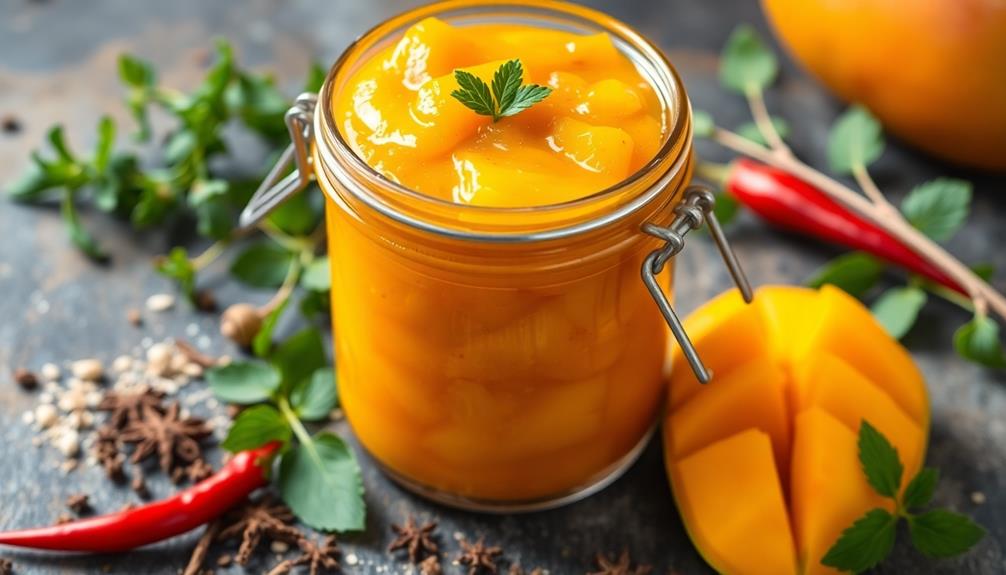
Mango chutney's versatility is perhaps its greatest appeal. You can spread it on toast, use it as a dip for crackers, or even mix it into your favorite salad dressing. The possibilities are endless!
And once you've mastered this delicious recipe, you can experiment with different flavor combinations, like adding a hint of ginger or a sprinkle of cayenne pepper.
The best part about making your own mango chutney is that you can control the ingredients. No more worrying about artificial preservatives or added sugars – just pure, natural sweetness from the mangoes.
Plus, you'll have the satisfaction of knowing you created something truly special in your own kitchen.
Frequently Asked Questions
Where Can I Buy the Best Quality Mangoes for Chutney?
You can find the best quality mangoes for chutney at your local farmers' market or specialty grocery store. Look for ripe, juicy mangoes that are free of bruises and blemishes. The freshest mangoes will make the tastiest chutney.
How Long Does Homemade Mango Chutney Last in the Fridge?
Homemade chutney can typically last 2-3 weeks in the fridge if stored properly in an airtight container. The acidity and sugar content help preserve it, but it's best to check for signs of spoilage before using.
What Are the Health Benefits of Consuming Mango Chutney?
Consuming chutney can provide numerous health benefits. It's packed with vitamins and minerals that support your immune system, promote digestive health, and even reduce inflammation. Plus, the tangy flavor can liven up your meals in a delicious way.
Can I Use Green Mangoes Instead of Ripe Ones in Chutney?
Certainly, you can use green mangoes instead of ripe ones in your chutney. The unripe mangoes will provide a tangy and slightly sour flavor, which can be a delightful contrast to the sweetness of the other ingredients.
How Can I Adjust the Spiciness Level of Mango Chutney?
To adjust the spiciness level of your chutney, you can use more or less chili peppers. Add more for a spicier kick, or reduce the quantity for a milder flavor. Play around until you reach your desired level of heat.


